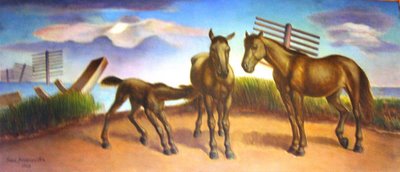 |
| Crissie Wright in 1886 winter storm |
 |
| Mailboat "Orville G" to Cape Lookout * |
 |
| Canadian geese used as decoys |
 |
| Wild sand ponies |
 (1941 photograph - Wikipedia)
(1941 photograph - Wikipedia)The artist, Simka Simkhovitch, was born in Petrograd, Russia on May 21, 1893 and died February 25, 1949 in Milford, Connecticut. He studied at the Royal Academy in St. Petersburg and was awarded a first prize by the First Soviet Government in 1918. But by 1924 the new Russian government had become repressive and Simka fled to the United States where he became a citizen. He had his first American exhibition in New York City in 1927.
After receiving a telegram from Beaufort Postmaster Wiley Higgins Taylor, Simkhovitch accepted the offer to paint the four murals for the Beaufort Post Office. The artist spent only a few days in Beaufort and returned to his Greenwich, Connecticut studio to paint the four large oil paintings on canvas. He was paid $1900 for his work.
Simkhovitch’s description of the four murals, as noted in his 1939 letter, included:
“The main one tells a local incident that occurred over fifty years ago, of the three-masted schooner Crissy Wright. One stormy, bitterly cold day this schooner was driven on one of their shoals, with a crew of six, whom it was impossible to rescue until the storm subsided. To keep up the spirit of the two men who showed signs of life on board, bonfires were built on the shore, while the rescuers waited until they could go out to the schooner. When they got to them the next day, four members were found frozen to death, and two were brought ashore still living, but subsequently died. Today, amongst the natives of Beaufort and its vicinity, very bad weather is proverbially known as a ‘Crissy Wright day.’
"The second panel shows the Cape Lookout Lighthouse erected after this accident; and the mailboat now employed to carry necessary supplies to the keeper and crew.
"The two other panels represent local colour. One of the Canadian geese used as decoys during the duck hunting season, with a fish net drying in the background. The other, of the legendary Sir Walter Raleigh wild sand ponies, who still roam the sand dunes and marshes of Beaufort in great numbers.”
The post office closed its doors in September 2010. When the town of Beaufort purchased the building in 2011, the USPS agreed to a 25-year loan of the murals. In return, the town agreed to maintain the historical aspects of the lobby, including keeping post office boxes in place.
Simkhovitch's works are in the permanent collections of the Dallas Museum of Art, the National Museum of American Art and the Whitney Museum of American Art.
* Mailboat "Orville G" was built by Carl Gaskill and named for his son Orville Grant Gaskill. The vessel also carried freight and passengers from "Down East" Carteret County to Beaufort. (By 1940, the Gaskill family lived at 709 Ann Street (purchased from Postmaster R.B. Wheatley.) C.G. Gaskill Company was on Front Street; it became Gaskill-Mace Hardware, and then Gaskill's Hardware, which closed its 900 Live Oak store in 2013.
